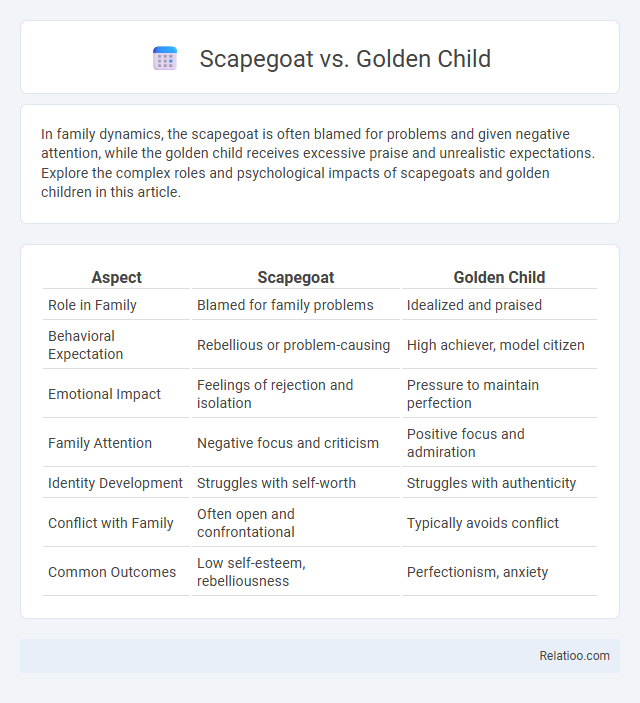In family dynamics, the scapegoat is often blamed for problems and given negative attention, while the golden child receives excessive praise and unrealistic expectations. Explore the complex roles and psychological impacts of scapegoats and golden children in this article.
Table of Comparison
| Aspect | Scapegoat | Golden Child |
|---|---|---|
| Role in Family | Blamed for family problems | Idealized and praised |
| Behavioral Expectation | Rebellious or problem-causing | High achiever, model citizen |
| Emotional Impact | Feelings of rejection and isolation | Pressure to maintain perfection |
| Family Attention | Negative focus and criticism | Positive focus and admiration |
| Identity Development | Struggles with self-worth | Struggles with authenticity |
| Conflict with Family | Often open and confrontational | Typically avoids conflict |
| Common Outcomes | Low self-esteem, rebelliousness | Perfectionism, anxiety |
Understanding the Family Roles: Scapegoat vs Golden Child
Understanding the family roles of Scapegoat vs Golden Child reveals contrasting dynamics where the Scapegoat often bears blame for family problems, absorbing criticism and acting out emotionally, while the Golden Child is idealized and praised, embodying the family's hopes and maintaining harmony. These roles serve to divert attention from dysfunctional issues and enable parents to project unmet needs or fears onto their children. Recognizing these patterns is crucial for addressing emotional wounds and breaking cycles of scapegoating within family systems.
Defining the Scapegoat in Dysfunctional Dynamics
The scapegoat in dysfunctional family dynamics is the individual unfairly blamed for problems, often absorbing collective guilt and criticism. This role contrasts with the golden child, who is idealized and given preferential treatment to maintain family stability. Understanding your position as the scapegoat helps recognize damaging patterns and facilitates emotional healing and boundary setting within toxic relationships.
Who is the Golden Child? Characteristics and Traits
The Golden Child is often the family member idealized for perfection, success, and compliance, frequently receiving excessive praise and high expectations from parents. Characteristics include strong achievement orientation, adaptability, approval-seeking behavior, and a tendency to suppress emotions to maintain the favored status. This role contrasts with the Scapegoat, who is blamed for family problems, highlighting dysfunctional family dynamics and enabling scapegoating patterns.
Origins of Scapegoat and Golden Child Roles
The origins of the scapegoat and golden child roles lie in family dynamics shaped by parental expectations and emotional needs, often arising from dysfunctional environments. The scapegoat is burdened with blame and criticism as a way to deflect guilt or unresolved issues, while the golden child is idealized and rewarded for meeting family ideals, creating a polarized family system. These roles originate from psychological mechanisms used to maintain family stability, despite underlying conflict or dysfunction.
Psychological Impact on the Scapegoat
The psychological impact on the scapegoat in family dynamics often includes chronic low self-esteem, anxiety, and feelings of worthlessness due to persistent blame and criticism, contrasting sharply with the idealization experienced by the golden child. Scapegoating can lead to long-term emotional trauma, including difficulty forming healthy relationships and increased risk of depression, as the scapegoat internalizes negative messages and unfairly assumes responsibility for family problems. Your mental health may suffer significantly as coping mechanisms are strained, making therapy and support essential for healing and reclaiming your self-worth.
Emotional Consequences for the Golden Child
The Golden Child often experiences immense pressure to maintain perfection and meet unrealistic parental expectations, leading to chronic anxiety and suppressed emotions. This role fosters identity struggles as the child may feel valued solely for achievements rather than genuine self-worth. Over time, emotional isolation and a fear of failure can dominate the Golden Child's psychological landscape, impacting their long-term mental health.
How Families Reinforce These Roles
Families reinforce the scapegoat and golden child roles through patterns of behavior, communication, and emotional dynamics that assign blame or idealization unfairly. Scapegoating occurs when one family member consistently bears blame for problems, diverting attention from underlying issues, while the golden child is idealized and held to high standards, embodying family hopes. Your awareness of these dynamics can help break toxic cycles by promoting healthier interactions and balanced accountability.
Signs You Might Be the Scapegoat or Golden Child
Signs you might be the scapegoat include being consistently blamed for family problems, feeling unappreciated, and experiencing emotional neglect or criticism that lacks justification. If you are the golden child, you may notice excessive praise tied to achievement, pressure to meet unrealistic expectations, and limited freedom to express flaws or mistakes. Both roles often involve imbalance in family dynamics, leading to identity struggles and emotional stress.
Breaking Free: Overcoming Family Role Conditioning
Breaking free from family role conditioning involving the scapegoat, golden child, or scapegoating requires recognizing these labels and understanding their impact on your identity and behavior. Your journey toward healing includes setting boundaries, seeking therapy, and reshaping self-perception beyond imposed roles. Overcoming these dynamics empowers you to establish healthier relationships and reclaim autonomy in your life.
Healing and Recovery Strategies for Both Roles
Healing from the trauma of being a scapegoat or a golden child requires personalized recovery strategies that address deep-rooted emotional wounds and codependency patterns. You can benefit from setting healthy boundaries, seeking therapy to rebuild self-esteem, and practicing self-compassion to overcome dysfunctional family dynamics and scapegoating cycles. Emphasizing emotional validation and redefining personal identity beyond imposed roles fosters long-term resilience and authentic self-growth.

Infographic: Scapegoat vs Golden Child
 relatioo.com
relatioo.com